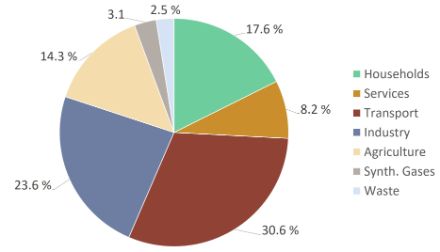Service Navigation
Search
There is solid global evidence of climate change, which is already having grave consequences in many parts of the world. An increase in heat-related events has been observed all over the world. Large regions of the globe are suffering more intense and frequent extreme precipitation events and drought. Furthermore, rising sea levels and the melting of ice and snow masses have been observed.
The consequences of climate change will increase in severity as the Earth continues to warm, and it has been demonstrated unequivocally that humans are the main drivers of climate change due to combustion of fossil fuels. This is why measures are needed to reduce greenhouse gas emissions globally in order to limit warming and the consequences associated with it.
In 1997, the international community agreed on binding reduction targets for industrialised nations in the form of the Kyoto Protocol. This expired in 2020 and was replaced by the Paris Agreement.
The Paris Agreement
The Paris Agreement was adopted in 2015 by the international community at the 21st Conference of the Parties of the United Nations Framework Convention on Climate Change (COP21). It is a legally binding instrument under the United Nations Framework Convention on Climate Change (Climate Convention, UNFCCC).
The goal of the Paris Agreement is to limit global warming to well below 2°C, and preferably to 1.5°C, compared to pre-industrial levels. This aims to prevent the most serious consequences of climate change from becoming a reality. In order to achieve these targets, there must be a rapid and substantial world-wide reduction in greenhouse gas emissions, and “net zero” must be achieved towards the middle of the century (1.5°C target) or during the course of the second half of the century (2°C target). “Net zero” emissions means that, ultimately, no more greenhouse gases must enter the atmosphere than are absorbed by natural sinks or technological carbon-capture methods.
Political targets for greenhouse gas reduction are often expressed in terms of the change in global mean temperature since pre-industrial times, the reason being that there is a strong and almost linear correlation between atmospheric greenhouse gas concentrations, the global radiation balance and, thus, the global mean temperature. This means that, as the greenhouse gas concentration in the atmosphere increases, the global mean temperature also increases. The temperature change over the long term is predominantly determined by the cumulative total amount of greenhouse gases emitted.
The evolution of many other climate indices is directly dependent on the global mean temperature, and global mean temperature is a more reliable and robust indicator of long-term climate trends than regional mean temperatures or other climate indices. For these reasons, it is a stable and well-suited indicator of the extent of global climate change, as well as the extent and intensity of many of its consequences.
The difference between the 1.5°C and 2°C targets
According to an Intergovernmental Panel on Climate Change (IPCC) Special Report, limiting warming to 1.5°C would have distinct advantages. The consequences and risks associated with climate change would be far less severe if warming were limited to 1.5°C rather than 2°C. Extremes such as heat waves, droughts and heavy precipitation would occur less frequently, the rise in sea levels would not be as large, and there would be less biodiversity loss. Critical tipping points such as the melting of the polar ice caps or the weakening of Atlantic ocean currents are less likely to be reached with 1.5°C warming, but cannot be ruled out altogether. Moreover, the measures needed to adapt to human-induced climate change will be smaller in the case of a 1.5°C warming.
Switzerland’s climate targets
Switzerland has also ratified the Paris Agreement, and is thus committed to a rapid and significant reduction in its greenhouse gas emissions. By 2030, it aims to have reduced greenhouse gas emissions by 50%, relative to 1990 levels, partly through the use of foreign emissions reductions. In Switzerland, the implementation of its international carbon-reduction commitments is enshrined in its CO2 Act. In addition, Switzerland is committed to monitoring its greenhouse gas emissions and making a greenhouse gas inventory available. Most of the country’s domestic greenhouse gas emissions occur in transport, industry, private households, agriculture and the services sector. However, this does not account for any emissions that are produced in the manufacturing of imported goods. In order for Switzerland to achieve its climate targets for 2030, rapid and comprehensive reductions in emissions in the areas of buildings, transport and industry need to take place.

Net zero by 2050
As part of its long-term climate strategy, Switzerland is aiming to further reduce its greenhouse gases to net zero by 2050. This means that the greenhouse gas sources and sinks must balance each other out by that time. However, it is left open as to what proportion of that reduction takes place in Switzerland and abroad. Switzerland is also contributing financially to measures designed to help developing countries reduce greenhouse gas emissions and adapt to climate change.
A further aim of the Paris Agreement is to align global financial flows with climate-friendly principles. This has relevance for Switzerland, since the financial sector plays an important role in the country’s economy. Furthermore, Switzerland is committed to measuring its greenhouse gas emissions and submitting a corresponding report under the terms of the Paris Agreement (Switzerland’s greenhouse gas emissions inventory).
Adapting to climate change
With a substantial global reduction in greenhouse gas emissions, many consequences of climate change can be mitigated, but not completely prevented. For this reason, measures are already needed today to adapt to climate change, and will become ever more important as global warming increases. Switzerland has had a climate-change adaptation strategy in place since 2012 and uses this as a basis for responding to the risks and opportunities associated with climate change. The implementation of the Strategy is regulated in the Action Plan, which consists of 75 federal-level measures. MeteoSwiss provides information on the current and future climate, including the Swiss climate scenarios.